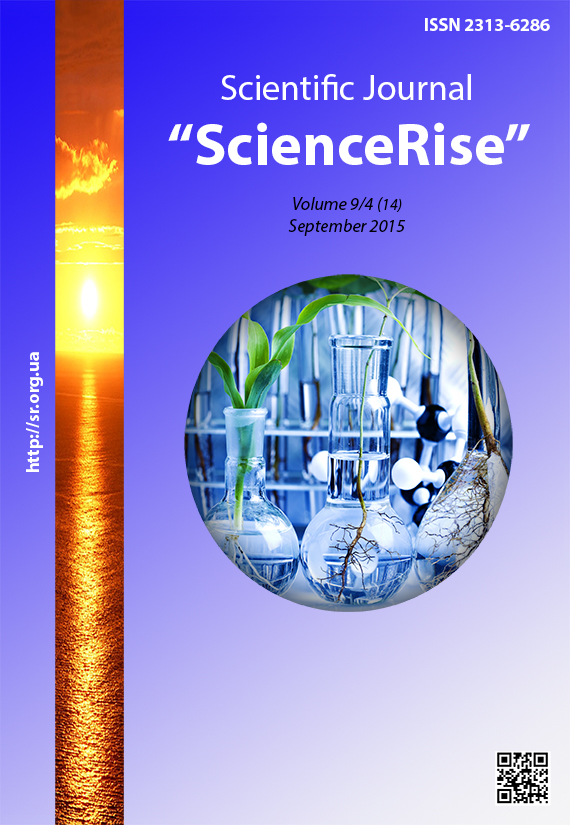Метаболічно-гіпоксичні порушення в формуванні діабетичної нефропатії при цукровому діабеті і типу у дітей
DOI :
https://doi.org/10.15587/2313-8416.2015.50605Mots-clés :
цукровий діабет І типу, діабетична нефропатія, метаболічні порушення, гіпоксіяRésumé
Діабетична нефропатія–одна з причин смертності хворих на цукровий діабет (ЦД).У пацієнтів з вперше виявленим ЦД І типу зафіксоване зростання дисоціації гемоглобіну та кисню і зниження цього показника) при діабетичній нефропатії. Виявлено високі рівні клітинної гіпоксії, зростання коефіцієнта окисненості ліпідів та стадійність змін їх рівнів в залежності від компенсованості ЦД
Références
Rojas, A., Morales, M. A. (2004). Advanced glycation and endothelial functions: A link towards vascular complications in diabetes. Life Sciences, 76 (7), 715–730. doi: 10.1016/j.lfs.2004.09.011
American Diabetes Association Standarts Of Medical Care In Diabetes (2015). The journal of clinical and applied research and education, 38, 1. Available at: http://diabetes.teithe.gr/UsersFiles/entypa/STANDARDS%20OF%20MEDICAL%20CARE%20IN%20DIABETES%202015.pdf
Vinod, P. B. (2012). Pathophysiology of diabetic nephropathy. Clinical Queries: Nephrology, 1 (2), 121–126. doi: 10.1016/S2211-9477(12)70005-5
Heilig, C. W., Deb, D. K., Abdul, A., Riaz, H., James, L. R., Salameh, J., Nahman, N. S. (2013). GLUT1 Regulation of the Pro-Sclerotic Mediators of Diabetic Nephropathy. American Journal of Nephrology, 38 (1), 39–49. doi: 10.1159/000351989
Ziyadeh, F. N., Hoffman, B. B., Han, D. C., Iglesias-de la Cruz, M. C., Hong, S. W., Isono, M. et. al. (2000). Long-term prevention of renal insufficiency, excess matrix gene expression, and glomerular mesangial matrix expansion by treatment with monoclonal antitransforming growth factor-beta antibody in db/db diabetic mice. Proceedings of the National Academy of Sciences, 97 (14), 8015–8020. doi: 10.1073/pnas.120055097
Wolf, G. Wolf, G., Ziyadeh, F. N. (2007). Cellular and Molecular Mechanisms of Proteinuria in Diabetic Nephropathy. Nephron Physiology, 106 (2), p26–p31. doi: 10.1159/000101797
Hadjadj, S., Tarnow, L., Forsblom, C., Kazeem, G., Marre, M., Groop et. al (2007). Association between Angiotensin-Converting Enzyme Gene Polymorphisms and Diabetic Nephropathy: Case-Control, Haplotype, and Family-Based Study in Three European Populations. Journal of the American Society of Nephrology, 18 (4), 1284–1291. doi: 10.1681/ASN.2006101102
Atkins, R. C., Zimmet, P. (2010). Diabetic kidney disease: act now or pay later. Journal of the American Society of Hypertension, 4 (1), 3–6. doi: 10.1016/j.jash.2009.12.001
Forbes, J. M. (2003). The breakdown of pre-existing advanced glycation end products is associated with reduced renal fibrosis in experimental diabetes. The FASEB Journal, 29 (6). doi: 10.1096/fj.02-1102fje
Chowdhury, R., Kunutsor, S., Vitezova, A., Oliver-Williams, C., Chowdhury, S., Kiefte-de-Jong, J. C. et. al (2014). Vitamin D and risk of cause specific death: systematic review and meta-analysis of observational cohort and randomised intervention studies. British Medical Journal, 348 (apr01 2), g1903–g1903. doi: 10.1136/bmj.g1903
Ivanov, Yu. G. (1975). Modifikatsiya spektrofotometricheskogo metoda opredeleniya kislorodnodissotsiatsionnykh krivykh gemoglobina. Byul. eksperimental'noy biologii i meditsiny, 79 (11), 122–123.
Pacher, P., Beckman, J. S., Liaudet, L. (2007). Nitric Oxide and Peroxynitrite in Health and Disease. Physiological Reviews, 87 (1), 315–424. doi: 10.1152/physrev.00029.2006
Hayashi, A., Suzuki, T., Shin, M. (1973). An enzymic reduction system for metmyoglobin and methemoglobin, and its application to functional studies of oxygen carriers. Biochimica et Biophysica Acta (BBA) – Protein Structure, 310 (2), 309–316. doi: 10.1016/0005-2795(73)90110-4
Shapiro, R., McManus, M. J., Zalut, C., Bunn, H. F. (1980). Sites of non-enzymatic glycosylation of human haemoglobin. J. Brit. Chem., 255 (7), 3120–3127.
Inoguchi, T., Li, P., Umeda, F., Yu, H. Y., Kakimoto, M., Imamura, M. et. al (2000). High glucose level and free fatty acid stimulate reactive oxygen species production through protein kinase C--dependent activation of NAD(P)H oxidase in cultured vascular cells. Diabetes, 49 (11), 1939–1945. doi: 10.2337/diabetes.49.11.1939
Artyukhov, V. G. (1995). Gemoproteidy: zakonomernosti fotokhimicheskikh prevrashcheniy v usloviyakh razlichnogo mikrookruzheniya. Voronezh: Izdatelstvo Voronezhskogo universitetata, 280.
Alinejad-Mofrad, S., Foadoddini, M., Saadatjoo, S. A., Shayesteh, M. (2015). Improvement of glucose and lipid profile status with Aloe vera in pre-diabetic subjects: a randomized controlled-trial. Journal of Diabetes & Metabolic Disorders, 14 (1), 2–7. doi: 10.1186/s40200-015-0137-2
Reidy, K., Kang, H. M., Hostetter, T., Susztak, K. (2014). Molecular mechanisms of diabetic kidney disease. Journal of Clinical Investigation, 124 (6), 2333–2340. doi: 10.1172/jci72271
Holick, M. F. (2007). Medical progress: Vitamin D deficiency. The New England Journal of Medicine, 357 (3), 266–281. doi: 10.1056/nejmra070553
Goldin, A., Beckman, J. A., Schmidt, A. M., Creager, M. A. (2006). Advanced Glycation End Products: Sparking the Development of Diabetic Vascular Injury. Circulation, 114 (6), 597–605. doi: 10.1161/circulationaha.106.621854
Oh, J., Weng, S., Felton, S. K., Bhandare, S., Riek, A., Butler, B. et. al. (2009). 1,25(OH)2 Vitamin D Inhibits Foam Cell Formation and Suppresses Macrophage Cholesterol Uptake in Patients With Type 2 Diabetes Mellitus. Circulation, 120 (8), 687–698. doi: 10.1161/circulationaha.109.856070
Téléchargements
Publié-e
Numéro
Rubrique
Licence
(c) Tous droits réservés Євгенія Анатоліївна Бурлака, Виталий Григорьевич Майданник 2015

Cette œuvre est sous licence Creative Commons Attribution 4.0 International.
Our journal abides by the Creative Commons CC BY copyright rights and permissions for open access journals.
Authors, who are published in this journal, agree to the following conditions:
1. The authors reserve the right to authorship of the work and pass the first publication right of this work to the journal under the terms of a Creative Commons CC BY, which allows others to freely distribute the published research with the obligatory reference to the authors of the original work and the first publication of the work in this journal.
2. The authors have the right to conclude separate supplement agreements that relate to non-exclusive work distribution in the form in which it has been published by the journal (for example, to upload the work to the online storage of the journal or publish it as part of a monograph), provided that the reference to the first publication of the work in this journal is included.

